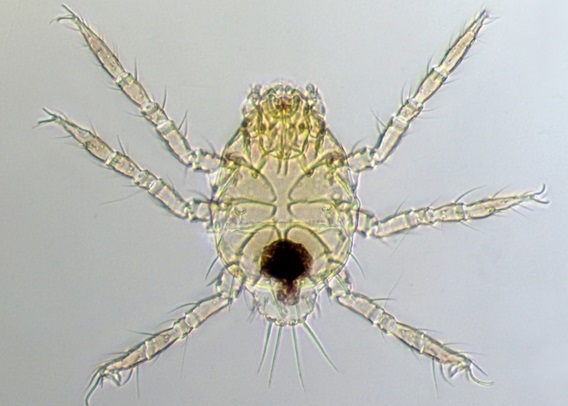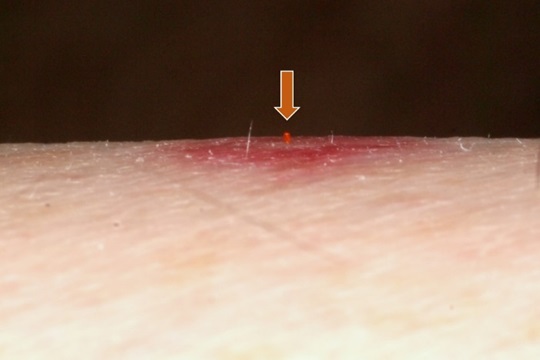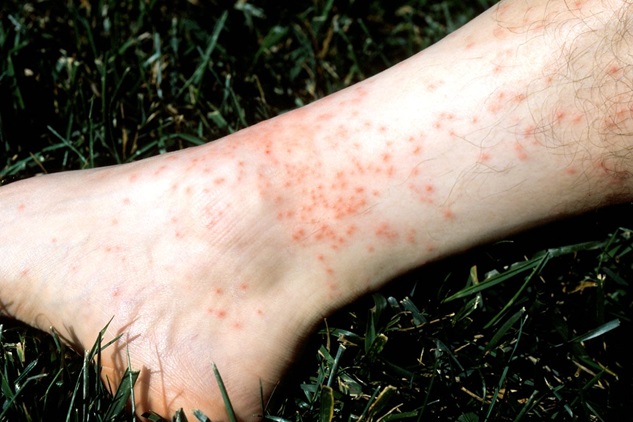Dealing with Chiggers in the Landscape
ENTFACT-630: Dealing with Chiggers in the Landscape | Download PDF | En Español
by Jonathan L. Larson, Extension Entomologist
University of Kentucky College of Agriculture
Fast Facts
- Chiggers are immature mites that feed on the skin of animals and induce an aggravating rash with an intense itchy feeling.
- They are most commonly encountered in overgrown areas but can live in yards and near parks and camps where they will spoil a nice weekend outside.
- Skin based repellents for ticks and mosquitoes can also repel chiggers. DEET is the best option for your skin, permethrin is an insecticide you can apply to clothing.
- Over the counter medications, like hydrocortisone, may help, though the itchy symptoms will likely persist for about 10-14 days.
Pest Description, Feeding Style, and Symptoms
Chiggers are barely visible to the naked eye. You likely won’t see them in the landscape or when they are on your body to feed. If you were to look at one under a microscope or powerful magnifying glass, you would notice that they have six legs, and they are usually reddish in color.
Chiggers are parasites that feed on digested skin cells. They are the immature larval stage of a predatory mite. When chiggers are on their host, they will insert a tube-like mouthpart into the skin. Then, they will pump in their “saliva” which will dissolve the nearby skin cells. After this, they will slurp up the resulting skin slurry. This can happen over the course of 2-4 days. It is important to note that chiggers are external parasites. The mite doesn’t burrow into the skin.

Figure 1: As immature mites, chiggers only have six legs.
They are almost invisible to the naked eye; this image is highly magnified to show their body plan off.
Photo by Jim Kalisch, UNL Entomology
The effects of chigger feeding are much more noticeable than the chigger itself. Bites are usually located in areas with thinner skin, or an area being constricted by clothing. Common bite sites are the ankles, behind knees, the groin area, the waistband area, in armpits, and around bra lines. The effects of being bitten may not appear for 12-24 hours after exposure to the chiggers. The area bitten can be inflamed and hardened, with a reddish hue. The center may have a red dot and be sunken, they could be red and slightly raised, they may also develop a large pustule that can pop like a blister. Different individuals may react differently to bites from parasites.

Figure 2: Chiggers are external parasites only; they do not burrow into your skin and live there.
The orange arrow in this image is pointing to a chigger feeding on a person’s leg.
Photo by Jim Kalisch, UNL Entomology
Life Cycle in Kentucky
Chiggers overwinter as adults, hiding in the soil until spring. When temperatures begin to rise, the soil temperature will be around 60 °F, they will emerge and mate. The eggs will then be laid in the soil as well, usually in habitats that are overgrown. After the eggs hatch, the chiggers that attack humans and pets will then crawl to the ends of blades of grass or tips of other plants and wait for a host. After feeding, this parasitic stage will fall off of the host and molt to the next stage. In Kentucky, there can be multiple generations of chiggers with bites possibly occurring over the entire growing season but peaks in spring and late summer.
How to Protect Yourself
To avoid chigger habitats, you can try to avoid entering unmown or overgrown areas and stick to managed trails. Wearing long pants, that are tucked into socks or shoes, and long sleeves can reduce the ability of chiggers to reach your skin. When you come in from outdoor activities, even short ones like weeding, you can also dislodge chiggers by wiping your legs down with a dry towel or taking a quick shower and scrubbing your lower appendages.
Using insect repellents on your skin can also protect you from chiggers. Skin based repellents include DEET, picaridin, IR-3535, and oil of lemon eucalyptus. These also help to repel ticks and mosquitoes. Depending on the percentage of the active ingredient in the product and the amount of time you plan to spend outside, you may need to make multiple applications to ensure protection.
Beyond skin-based repellents, if you will be spending extended periods of time in chigger habitat (i.e., working outside, camping, hunting, etc.) you can treat your clothing with permethrin. This is a true insecticide, so it shouldn’t be applied to the skin but once it is dry on clothing, it will kill chiggers (as well as ticks and other pests) when they climb onto you clothing.
If you do get chigger bites, they can be treated with over-the-counter medication (such as hydrocortisone, calamine lotion, etc.) or you may want to consult with a medical professional about prescriptions to help with relief.

Figure 3: The ankles, knees, groins, waists, and armpits are all chigger bit hotspots.
People can be bitten by a few to many chiggers and react in different ways.
Some develop dots like we see here, others may end up with pustule-like bites.
Photo by Jim Kalisch, UNL Entomology
Treating Chigger Habitats
Long-term solutions to chiggers include brush removal, mowing, and landscape management to cut down on suitable habitats. Increasing light penetration and reducing humidity in given areas (by opening them up through plant removal) can reduce chigger attraction to an area. It also reduces habitat for other potential chigger hosts, meaning there could be fewer chiggers in that area.
Insecticides won’t provide long-term control over chiggers but can help to reduce populations quickly so you can get back outside and work or enjoy your landscape. Hot spot treatments with products containing bifenthrin, permethrin, cyhalothrin, or carbaryl would provide 1-2 weeks of control (depending on the product used and the weather). Follow label directions but treat the afflicted vegetation up to a height of about three feet. Treating in April or May would provide effective timing, in serious infestations there may need to be a follow up application in June.
Revised: 05/22
CAUTION! Pesticide recommendations in this publication are registered for use in Kentucky, USA ONLY! The use of some products may not be legal in your state or country. Please check with your local county agent or regulatory official before using any pesticide mentioned in this publication.
Of course, ALWAYS READ AND FOLLOW LABEL DIRECTIONS FOR SAFE USE OF ANY PESTICIDE!
Images: University of Kentucky Entomology
